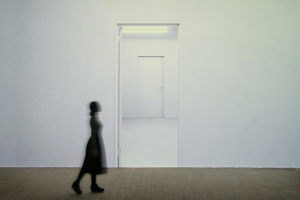The shop seemed to be full of all manner of curious things – but the oddest part of it all was that, whenever she looked hard at any shelf, to make out exactly what it had on it, that particular shelf was always quite empty, though the others round it were crowded as full as they could hold.
Lewis Carroll, Through the Looking Glass
As you see, in my work expands empty museum or gallery space without any art works exhibited inside. In normal circumstances it is only during the short period of time, after the exhibitions are dismantled and removed, when we can observe such sight. Visitors to art museums or galleries may take it for granted that these spaces are always adorned with works of art and they stay as such for good. As everything comes to an end one day, in reality, and every exhibition will finish at one point without any exception. Importantly, the time after the end of one exhibition, is the time before the beginning of another. In between the exhibitions in the art museums or galleries where innumerable shows take place, one feels the air, mixture of remaining ambiance of the works previously exhibited, and that of the works to be brought in in coming days, mingled in the empty space, or the void. The void eloquently speaks of the loss and absence precisely because of its nature of silent space devoid of objects. It stirs the imagination for the unknown, and is filled with the energy presaging what is to come. In the contemporary society brimmed with information and works of art, I propose to explore potentials to establish meaningful relations with the world through dialogue with the void, a symbol of the unknown. This exhibition will too one day come to an end, and the empty gallery rooms will once again appear. As you will see it, it will be the same landscape as the one the audience finds depicted in my very works that would have been exhibited at the exact space.
(March in 2019)
As you see it (見てのとおり)
(その店は)ありとあらゆる種類のへんてこりんな物でいっぱいのようでした – でも、なによりおかしいのは、棚の上にいったいなにがあるのか確かめようとしてよくよく見ると、どの棚も、見たその棚だけがいつでもまるでからっぽなのでした、その周りの棚にははいりきらないほどいっぱいに物がつまっているというのに
ルイス・キャロル『鏡の国のアリス』
私の作品においては、見てのとおり何も作品がない空っぽの美術館やギャラリーの風景が広がっている。私たちが通常そのような状況を実際に見ることができるのは、展覧会の後に会場から作品が運び出されたわずかな時間に限られている。美術館やギャラリーは往々にして多くの作品で溢れかえっていて、それらはまるで永遠にその場に在り続けるかのように来訪者の眼に映るかもしれない。しかしあらゆることに終りがあるように、どのような展覧会にも必ず終りは訪れる。ここで大切なことは、それは展覧会の後であると同時に別の展覧会の前でもあるということだ。何度も展覧会が繰り返される美術館やギャラリーの空虚には、かつてそこにあった作品とこれからそこにやってくる新たな作品の気配が入り混じっている。空虚は、それが何もない沈黙の空間であればこそ雄弁に喪失と不在を語る。そしてそれは未知なるものへの想像を掻き立て、これから新たに到来するものを予兆するエネルギーに満ちている。私は、膨大な数の情報と作品が行き交う現代において、不可視のもの、不可知なるものを象徴する空虚との対話の中に、この世界との関係性を成立させる契機を見出し、その知の在り方を提示する。私の展覧会もやがて終りを迎え、そこには空っぽの展示室が再び現れる。見てのとおり、それはかつてその場所に展示されていた私の作品の中と同じ風景なのである。
(2019年3月)
注:『鏡の国のアリス』の訳文は、スーザン・ソンタグ『ラディカルな意志のスタイル』川口喬一訳、晶文社〈晶文選書〉、1974年、p.18から引用。
